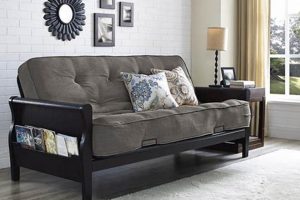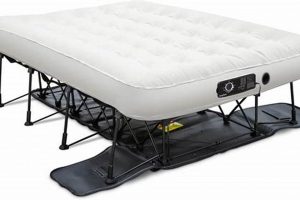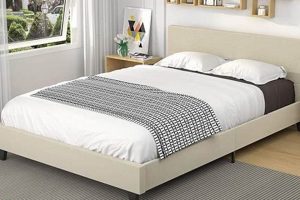A structure designed to provide stable, even foundational assistance for a sleep surface. These platforms elevate the mattress off the floor, contributing to both comfort and longevity. Examples include metal frames, wooden foundations, and adjustable bed bases, each offering varying levels of support and features.
The structural base plays a vital role in ensuring proper spinal alignment and reducing pressure points during sleep. Its construction influences the overall feel of the mattress and can impact temperature regulation by allowing for airflow. Historically, simple bed frames have evolved into sophisticated systems incorporating features such as motorized adjustments and built-in storage.
The selection of an appropriate base is paramount. Factors such as mattress type, desired height, and budget considerations greatly influence the decision-making process. Understanding these aspects will lead to a more informed choice and ultimately enhance the sleep experience.
Optimizing Your Sleep with the Right Base
Selecting the correct structural foundation can significantly impact mattress performance and lifespan. Consider these factors to ensure optimal support and longevity.
Tip 1: Match the Frame to the Mattress Type: Different mattresses require different support levels. Innerspring mattresses often work well with standard metal frames, while memory foam and hybrid mattresses may benefit from solid platforms or adjustable bases to prevent sagging.
Tip 2: Ensure Adequate Center Support: Larger mattresses, particularly queen and king sizes, require a center support beam or leg to prevent bowing and maintain even weight distribution.
Tip 3: Consider the Height: The overall bed height, including the structure, should be comfortable for getting in and out of bed. Low-profile options can create a modern aesthetic, while taller frames provide under-bed storage.
Tip 4: Check for Noise Reduction Features: Squeaky or noisy frames can disrupt sleep. Look for frames with secure connections and consider adding felt pads to minimize friction.
Tip 5: Inspect the Construction Material: Metal frames offer durability and affordability, while wooden foundations can add a touch of style. Ensure the material is robust and free from defects.
Tip 6: Verify Weight Capacity: Confirm the frame’s weight capacity to ensure it can adequately support the mattress and occupants without compromising stability.
Tip 7: Prioritize Proper Assembly: Correct assembly is crucial for optimal performance. Follow the manufacturer’s instructions carefully and tighten all connections securely.
By considering these factors, individuals can choose a structural base that complements their mattress, promotes proper sleep posture, and extends the lifespan of their investment.
The following sections will delve into specific types of these foundational supports and their respective benefits.
1. Material Durability
Material durability, in the context of a support structure for mattresses, directly influences its lifespan and performance. A robust construction resists deformation under prolonged and repeated stress. The choice of material, therefore, dictates the structure’s ability to maintain its intended form and function over time. Inferior materials may exhibit premature wear, leading to sagging, instability, and ultimately, compromised sleep quality. For example, a frame constructed from low-gauge steel is more susceptible to bending and breakage compared to one fabricated from higher-gauge steel or reinforced wood.
Consider the practical implications of material selection. Wood, while aesthetically pleasing, may warp or crack under consistent weight and humidity changes, especially if it is not properly treated and sealed. Similarly, plastic components, often found in cheaper frames, are prone to brittleness and failure when subjected to significant loads. The importance of material durability extends beyond mere longevity; it impacts the level of support provided to the mattress, which in turn affects spinal alignment and overall comfort. A failing structure will result in uneven support, potentially exacerbating back pain and disrupting sleep patterns.
In conclusion, material durability is not merely a superficial attribute but a critical determinant of a supporting base’s effectiveness. The selection of high-quality, durable materials ensures long-term structural integrity, consistent support, and ultimately, a better sleep experience. Ignoring material durability results in compromised performance and reduced lifespan, thereby negating any potential cost savings associated with cheaper alternatives. The initial investment in a durable unit offers long-term value and improved sleep quality.
2. Weight Capacity
Weight capacity is a critical specification that directly influences the functionality and safety of a structural base. It represents the maximum load, encompassing the mattress and occupants, that the structure is designed to support without risk of failure or compromised performance. Understanding and adhering to the specified weight capacity is paramount for ensuring longevity, stability, and user safety.
- Structural Integrity and Material Stress
Exceeding the weight capacity can induce undue stress on the materials, leading to bending, warping, or fracturing. This can compromise the frame’s ability to provide even support, resulting in sagging, discomfort, and potentially voiding warranties. For example, a metal frame rated for 500 pounds may buckle under a load of 700 pounds, causing instability and uneven weight distribution.
- Joint and Connection Strength
The joints and connections within a frame are often the weakest points. Weight capacity ratings account for the strength of these connections. Overloading the frame places excessive force on these joints, potentially causing them to loosen, shear, or break. A wooden foundation with poorly constructed joints may collapse under excessive weight, posing a safety hazard.
- Impact on Mattress Performance
The ability of a mattress to perform optimally is directly tied to the underlying support. An inadequate frame, one that exceeds its capacity, will not provide the necessary stability and even distribution of weight. This can lead to premature wear and tear of the mattress, uneven sleeping surfaces, and reduced comfort. A memory foam mattress, for instance, requires a solid, stable surface to prevent sagging and maintain its conforming properties.
- Safety and Liability Considerations
Ignoring weight capacity limits poses significant safety risks. Frame failure can result in injury to occupants. Furthermore, manufacturers typically disclaim liability for damages or injuries resulting from exceeding the specified weight capacity. Adhering to the recommended weight limits ensures responsible use and mitigates potential safety hazards.
In summary, weight capacity is a fundamental consideration when selecting a structural mattress foundation. It ensures structural integrity, extends mattress life, and protects the safety of users. Mismatched weight capacity could cause serious failures.
3. Dimensional Accuracy
Dimensional accuracy, in the context of a structural base for a mattress, refers to the precision with which the frame’s measurements align with the mattress’s specified dimensions. This alignment is crucial for ensuring optimal support, preventing premature wear, and maintaining overall sleep quality.
- Prevention of Mattress Movement
A frame with accurate dimensions prevents excessive mattress shifting. When the frame is too large, the mattress can slide, creating uneven support and disrupting sleep. Conversely, a frame that is too small can compress the mattress, leading to deformation and reduced lifespan. For example, a queen-sized mattress (typically 60×80 inches) placed on a frame slightly larger than these dimensions will tend to move, particularly during sleep. The movement generates noise and inconsistent support.
- Even Weight Distribution
Dimensional inaccuracies can lead to uneven weight distribution across the mattress surface. If the frame’s dimensions deviate from the mattress’s specifications, certain areas of the mattress may receive more or less support than others. This concentrated stress can accelerate wear and tear, especially in areas that consistently bear the brunt of the load. An example would be a support base that is slightly bowed or uneven, causing the mattress to compress unevenly.
- Maintenance of Mattress Shape
A dimensionally accurate frame assists in preserving the mattress’s intended shape. Ill-fitting support can distort the mattress over time, compromising its comfort and support characteristics. This is particularly important for mattresses with specialized construction, such as those containing memory foam or individual pocketed coils. An inaccurately sized frame may squeeze or stretch these components, degrading their performance.
- Maximizing Usable Sleep Surface
Correct dimensions ensure the entire mattress surface is usable for sleep. When the structural base is not dimensionally accurate, portions of the mattress may overhang or lack adequate support, effectively reducing the usable sleep area. This is especially relevant for smaller bedrooms where every inch of available sleep surface is valuable. A frame that is too narrow or short will leave portions of the mattress unsupported, leading to discomfort and potential damage.
Dimensional accuracy is not merely a cosmetic consideration; it is fundamental to the performance and longevity of both the mattress and its supporting base. Precise alignment ensures optimal support, prevents premature wear, and maximizes the usable sleep surface, contributing to a more comfortable and restful sleep experience.
4. Structural Integrity
Structural integrity, within the context of a mattress support frame, refers to the frame’s ability to withstand applied forces and maintain its intended shape and load-bearing capacity over time. The structural integrity of a support frame directly impacts the performance and longevity of the mattress it supports. Compromised structural integrity results in uneven weight distribution, sagging, and potential failure, diminishing both comfort and the lifespan of the mattress. For instance, a metal frame with weakened welds or a wooden foundation with damaged supports lacks the necessary structural integrity to properly support a heavy mattress and its occupants. The effects manifest as noticeable dips, squeaking noises, and a general instability of the sleeping surface.
The materials used in construction, the design of the frame, and the quality of assembly all contribute to its structural integrity. Higher-gauge steel, solid hardwood, and reinforced joints enhance load-bearing capacity and resistance to deformation. Frames designed with center support beams are better equipped to handle the weight of larger mattresses. In contrast, frames made from low-quality materials or assembled with inadequate fasteners are prone to failure. The connection points are particularly vulnerable, and any weakness there amplifies stress on other components, accelerating degradation. Consider the implications of a lightweight frame supporting a heavy memory foam mattress; the frame will likely flex and warp, leading to uneven support and eventual breakdown.
Maintaining structural integrity requires routine inspection and proper use. Regularly checking for loose bolts, damaged welds, or signs of wood rot can prevent catastrophic failures. Adhering to the manufacturer’s weight limits is also essential. Ignoring these factors can lead to compromised sleep quality, premature mattress wear, and potential safety hazards. The long-term benefits of selecting a structurally sound unit outweigh the initial cost savings of cheaper, less robust alternatives. The selection has the effect of assuring quality sleep.
5. Compatibility
Compatibility between a mattress and its support frame is a fundamental determinant of sleep quality and the longevity of both components. Optimal performance necessitates careful consideration of various factors to ensure harmonious interaction.
- Mattress Type and Frame Design
Different mattress types require specific support characteristics. Innerspring mattresses often perform well with standard metal frames, while memory foam and hybrid mattresses may necessitate solid platforms or adjustable bases to prevent sagging. The design of the support structure should align with the inherent properties of the mattress.
- Weight Distribution and Frame Strength
The support frame must be capable of evenly distributing the mattress’s weight and the weight of the occupants. Insufficient frame strength can lead to uneven support, premature wear, and potential structural failure. For example, a lightweight metal frame may not adequately support a heavy latex mattress, resulting in localized stress points and reduced comfort.
- Ventilation and Airflow
Certain mattress materials, such as memory foam, can trap heat. The support frame should facilitate adequate airflow to prevent overheating and promote a comfortable sleeping environment. Slatted frames or open foundations enhance ventilation compared to solid platforms. Proper ventilation is a key factor.
- Size and Dimensional Accuracy
The dimensions of the support frame must precisely match the dimensions of the mattress. An ill-fitting frame can lead to mattress movement, uneven support, and reduced usable sleep surface. Compatibility requires the two dimensions to align.
In summary, compatibility extends beyond mere physical fit. It encompasses structural, material, and dimensional considerations to ensure optimal performance and prolonged lifespan. A comprehensive assessment of compatibility factors enhances sleep quality.
Frequently Asked Questions
This section addresses common inquiries regarding mattress foundations, providing clear and concise information to aid in informed decision-making.
Question 1: What is the lifespan of a typical foundation?
The lifespan varies based on material and usage. Metal frames, properly maintained, can last upwards of 10 years. Wooden foundations may require replacement sooner, typically within 5-7 years, depending on the quality of construction and environmental factors.
Question 2: Does the choice of foundation affect the mattress warranty?
Yes, using an incompatible or inadequate foundation can void a mattress warranty. Manufacturers often specify requirements for support, such as the type of frame, spacing of slats, or presence of center support.
Question 3: What are the advantages of an adjustable bed base?
Adjustable bases offer customizable support, allowing users to elevate the head and/or feet. This can alleviate pressure points, improve circulation, and enhance comfort for activities such as reading or watching television in bed.
Question 4: How does foundation height impact sleep?
Foundation height affects the overall bed height, which is a matter of personal preference. A higher bed may be easier to get in and out of, particularly for individuals with mobility issues. Lower foundations create a more modern aesthetic.
Question 5: Are bed slats sufficient support for a mattress?
Slats can provide adequate support, provided they are properly spaced and sufficiently strong. Wider spacing or flimsy slats can lead to mattress sagging and uneven weight distribution.
Question 6: Can a foundation improve mattress breathability?
Yes, certain foundation designs, such as slatted frames, promote airflow around the mattress. This is particularly beneficial for memory foam mattresses, which tend to retain heat.
In summary, the selection of an appropriate mattress foundation is crucial for maintaining mattress integrity, ensuring warranty compliance, and optimizing sleep comfort. Careful consideration of these factors is warranted.
The next section will focus on common problems associated with these support structures, along with potential solutions.
Conclusion
This exploration of the mattress support frame has underscored its critical role in achieving optimal sleep quality and prolonging mattress lifespan. Understanding the nuances of material durability, weight capacity, dimensional accuracy, structural integrity, and compatibility is essential for informed decision-making. A properly chosen frame not only enhances comfort but also protects the investment in a quality mattress.
Neglecting the importance of the mattress support frame can lead to compromised sleep, premature wear of the mattress, and potential safety hazards. Therefore, careful consideration and appropriate selection are paramount for a sound and restful sleep experience. Continued awareness and adherence to best practices regarding foundational support structures will contribute to improved sleep health and overall well-being.


![Best Frame for Air Mattress [Guide] & Setup Tips Organic & Natural Mattress Buyer’s Guide: Non-Toxic Sleep Solutions Best Frame for Air Mattress [Guide] & Setup Tips | Organic & Natural Mattress Buyer’s Guide: Non-Toxic Sleep Solutions](https://mattressworldpa.com/wp-content/uploads/2025/07/th-3040-300x200.jpg)



![Best Metal Frame Futon with Mattress [Deals!] Organic & Natural Mattress Buyer’s Guide: Non-Toxic Sleep Solutions Best Metal Frame Futon with Mattress [Deals!] | Organic & Natural Mattress Buyer’s Guide: Non-Toxic Sleep Solutions](https://mattressworldpa.com/wp-content/uploads/2025/07/th-3036-300x200.jpg)
